NCERT Solutions for Class 12 Physics Chapter 4 - Moving Charges and Magnetism
CBSE Class 12th Exam Date:01 Jan' 26 - 14 Feb' 26
Have you ever questioned how an electric fan spins when you pass a current through the motor or how a magnetic compass needle bounces off a current-carrying wire? These common things in our daily life are practical demonstrations of the concepts of Chapter 4 of Physics Class 12 - Moving Charges and Magnetism.
This Story also Contains
- Moving Charges and Magnetism Class 12 Question Answers: Download PDF
- Moving Charges and Magnetism NCERT Solutions: Exercise Questions
- Moving charges and magnetism NCERT Solutions: Additional Questions
- Class 12 Physics Chapter 4 - Moving charges and magnetism: Higher Order Thinking Skills (HOTS) Questions
- Moving Charges and Magnetism Class 12 Question Answers: Topics
- Class 12 Physics Chapter 4 - Moving charges and magnetism: Important Formulas
- Approach to Solve Questions of Class 12 Physics Chapter 4 - Moving charges and magnetism
- What Extra Should Students Study Beyond the NCERT for JEE/NEET?
- Importance in Exams
- NCERT Solutions for Class 12 Physics: Chapter-Wise
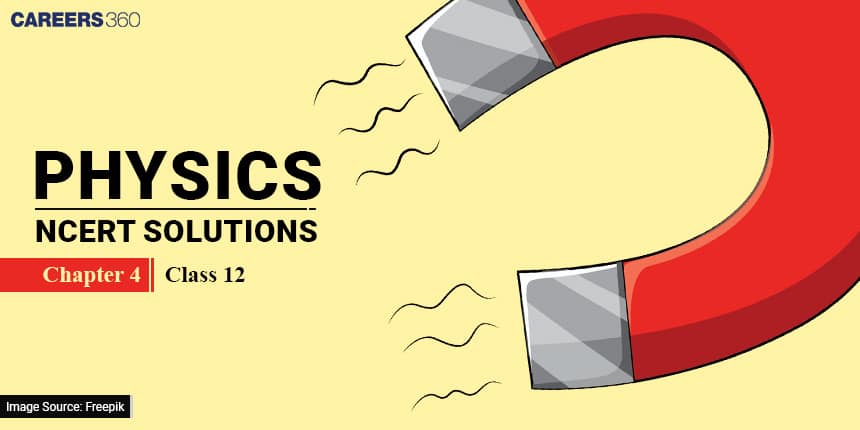
NCERT Solutions for Class 12 Physics Chapter 4 - Moving charges and magnetism, are aimed at providing step-wise explanation of all the exercise problems so that the students can readily comprehend the process of application of the laws of magnetism. Such Moving charges and magnetism class 12 question answers have a great benefit in establishing solid foundations that can be needed to pass the CBSE Class 12 board exams, JEE, NEET, and other competitive exams. These NCERT solutions contain elaborated answers to exercise questions, extra questions, and HOTS (Higher Order Thinking Skills) in order to enhance the problem-solving capability. The students also have a good explanation of some of the significant formulas and derivation, including Biot-Savart Law, Ampere Circuital Law, Magnetic Field due to a Current Loop and Force on a Current-carrying Conductor. The main concepts that were discussed in this chapter are the Lorentz Force and Motion of a Charged Particle in a Magnetic Field, Applications of Biot-Savart Law, Force between Two Parallel Current-Carrying Wires, Ampere Law and Applications, as well as the Moving Coil Galvanometer. By using these organised NCERT Solutions for Class 12 Physics Chapter 4 - Moving charges and magnetism, the student is able to not only revise but also have confidence in their ability to apply physics concepts to real-life and exam-level problems.
Moving Charges and Magnetism Class 12 Question Answers: Download PDF
The Class 12 Physics Chapter 4 - Moving charges and magnetism question answers are available in the structure of a well-formatted PDF file to the students. The downloadable class 12 physics chapter 4 Moving charges and magnetism questions answers are available with step-by-step instructions for all the exercises, new questions, and HOTS, and the preparation and revision of the exams becomes simpler and more efficient. The PDF becomes a valuable tool in order to reinforce the conceptual clarity and train problem-solving skills at any place and any time.
Moving Charges and Magnetism NCERT Solutions: Exercise Questions
The Class 12 Physics Chapter 4 - Moving charges and magnetism Exercise Questions are answered in a very clear, stepwise fashion so as to enable the student to enhance his/her understanding of all the concepts. All these class 12 physics chapter 4 Moving charges and magnetism questions answers offer comprehensive explanations to every problem, and so it becomes simpler to practice numericals, solve equations, and prepare well to take exams such as CBSE, JEE, and NEET.
Answer :
The magnitude of the magnetic field at the centre of a circular coil of radius r carrying current I is given by,
$|B|=\frac{\mu _{0}I}{2r}$
For 100 turns, the magnitude of the magnetic field will be,
$|B|=100\times \frac{\mu _{0}I}{2r}$
(Given, current=0.4A, radius = 0.08m, permeability of free space = 4 $\pi \times$ 10 -7 TmA-1)
$|B|=100\times \frac{4\pi \times 10^{-7}\times 0.4}{2\times 0.08}=3.14\times10^{-4}T$
Answer:
The magnitude of the magnetic field at a distance r from a long straight wire carrying current I is given by,
$|B|=\frac{\mu _{0}I}{2\pi r}$
In this case
(Given, current=0.4A, radius = 0.08m, permeability of free space = 4 $\pi \times$ 10 -7 TmA-1)
$|B|=\frac{4\pi \times 10^{-7}\times 35}{2\pi\times 0.2}=3.5\times 10^{-5}T$
Answer:
The magnitude of the magnetic field at a distance r from a long straight wire carrying current I is given by,
$|B|=\frac{\mu _{0}I}{2\pi r}$
In this case
(Given, current=0.4A, radius = 0.08m, permeability of free space = 4 $\pi \times$ 10 -7 TmA-1)
$|B|=\frac{4\pi \times 10^{-7}\times 50}{2\pi\times 2.5}=4\times10^{-6}T$
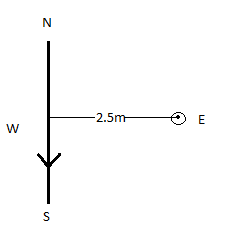
The current is going from the North to the South direction in the horizontal plane, and the point lies to the East of the wire. Applying Maxwell's right-hand thumb rule, we can see that the direction of the magnetic field will be vertically upwards.
Answer:
The magnitude of the magnetic field at a distance r from a long straight wire carrying current I is given by,
$|B|=\frac{\mu _{0}I}{2\pi r}$
In this case
(Given, current=0.4A, radius = 0.08m, permeability of free space = 4 $\pi \times$ 10 -7 TmA-1)
$|B|=\frac{4\pi \times 10^{-7}\times 90}{2\pi\times 1.5}=1.2\times10^{-5} T$
The current in the overhead power line is going from East to West direction and the point lies below the power line. Applying Maxwell's right-hand thumb rule, we can see that the direction of the magnetic field will be towards the South.
Answer:
The magnetic force on an infinitesimal current-carrying conductor in a magnetic field is given by $\vec{dF}=I\vec{dl}\times \vec{B}$ where the direction of vector dl is in the direction of flow of current.
For a straight wire of length l in a uniform magnetic field, the Force equals
$\\\vec{F}=\int_{0}^{l}I\vec{dl}\times \vec{B}\\ |\vec{F}|=BIlsin\theta$
In the given case, the magnitude of force per unit length is equal to
(Given, I=8A, B=0.15 T, $\theta$ =30o)
|F| = 0.15 $\times$ 8 $\times$ sin30o =0.6 Nm-1
Answer:
For a straight wire of length l in a uniform magnetic field, the Force equals
$\\\vec{F}=\int_{0}^{l}I\vec{dl}\times \vec{B}\\$
$\Rightarrow|\vec{F}|=BIlsin\theta$
In the given case, the magnitude of the force is equal to
(Given, I=10A, B=0.27 T, $\theta$ =90o)
|F| = 0.27 $\times$ 10 $\times$ 0.03 $\times$ sin90o =0.081 N
The direction of this force depends on the orientation of the coil and the current-carrying wire and can be known using Fleming's Left-hand rule.
Answer:
The magnitude of the magnetic field at a distance r from a long straight wire carrying current I is given by,
$|B|=\frac{\mu _{0}I}{2\pi r}$
In this case, the magnetic field at a distance of 4.0 cm from wire B will be
(Given, I=5 A, r=4.0 cm)
$|B|=\frac{4\pi \times 10^{-7}\times 5}{2\pi\times 0.04}=2.5\times10^{-5} T$
The force on a straight wire of length l carrying current I in a uniform magnetic field B is given by
$F=BI\sin\theta$, where $\theta$ is the angle between the direction of flow of current and the magnetic field.
The force on a 10 cm section of wire A will be
(Given, B=2.5 T, I=8 A, l = 10 cm, $\theta$ =90o)
$F=2.5\times10^{-5}\times8\times0.1 \times sin90^\circ$
$F=2\times10^{-5} N$
Answer:
The magnitude of the magnetic field at the centre of a solenoid of length $\ell$, total turns N and carrying current I is given by
$B=\frac{\mu _{o}NI}{l}$ , where $\mu _{o}$ is the permeability of free space.
In the given question N = number of layers of winding $\times$ number of turns per winding
N=5 $\times$ 400=2000
I=8.0 A
$ \ell=80 cm$
$B=\frac{4\pi \times 10^{-7}\times 2000\times 8}{0.8}$
$\\B=2.51\times10^{-2} T$
Answer:
The magnitude of torque experienced by a current-carrying coil in a magnetic field is given by
$\tau =nBIAsin\theta$
where n = number of turns, I is the current in the coil, A is the area of the coil, and $\theta$ is the angle between the magnetic field and the vector normal to the plane of the coil.
In the given question n = 20, B=0.8 T, A=0.1 $\times$ 0.1=0.01 m2 , I=12 A, $\theta$ =30o
$\tau =20\times 0.8\times 12\times 0.01\times sin30^{o}=0.96 Nm$
The coil, therefore, experiences a torque of magnitude 0.96 Nm.
4.10 (a) Two moving coil meters, $M_1$ and $M_2$ have the following particulars:
$R_1 = 10 \Omega , N_1 = 30,\\\\ A_1 = 3.6 \times 10^{-3} m^2, B_1 = 0.25 T\\\\$ $R_2 = 14 \Omega , N_2 = 42,\\\\ A_2 = 1.8 \times 10^{-3} m^2, B_2 = 0.50 T$
(The spring constants are identical for the two meters).
Determine the ratio of current sensitivity of $M_2\ and \ \ M_1$
Answer:
The torque experienced by the moving coil M1 for a current I passing through it will be equal to $\tau =B_{1}A_{1}N_{1}I$
The coil will experience a restoring torque proportional to the twist $\phi$
$\phi k=B_{1}A_{1}N_{1}I$
The current sensitivity is therefore $\frac{B_{1}A_{1}N_{1}}{k}$
Similarly, for the coil M2, current sensitivity is $\frac{B_{2}A_{2}N_{2}}{k}$
Their ratio of the current sensitivity of coil M2 to that of coil M1 is, therefore,
$\frac{B_{2}A_{2}N_{2}}{B_{1}A_{1}N_{1}}=\frac{0.5\times 1.8\times 10^{-3}\times 42 }{0.25\times 3.6\times 10^{-3}\times 30}=1.4$
4.10(b) Two moving coil meters, $M_1$ and $M_2$ have the following particulars:
Determine the ratio of voltage sensitivity of $M_2$ and $M_1$
Answer:
The torque experienced by the moving coil M1 for a current I passing through it will be equal to $\tau =B_{1}A_{1}N_{1}I$
The coil will experience a restoring torque proportional to the twist $\phi$
$\phi k=B_{1}A_{1}N_{1}I$
We know V=IR
Therefore, $\phi k=\frac{B_{1}A_{1}N_{1}V}{R_{1}}$
Voltage sensitivity of coil M1 = $\frac{B_{1}A_{1}N_{1}}{kR_{1}}$
Similarly for coil M2 Voltage sensitivity = $\frac{B_{2}A_{2}N_{2}}{kR_{2}}$
Their ratio of the voltage sensitivity of coil M2 to that of coil M1 is:
$\frac{B_{2}A_{2}N_{2}R_{1}}{B_{1}A_{1}N_{1}R_{2}}=1.4\times \frac{10}{14}=1$
Answer:
The magnetic force on a moving charged particle in a magnetic field is given by $\vec{F_{B}}=q\vec{v}\times \vec{B}$
Since the velocity of the shot electron is perpendicular to the magnetic field, there is no component of velocity along the magnetic field, and therefore, the only force on the electron will be due to the magnetic field and will be acting as a centripetal force, causing the electron to move in a circular path. (if the initial velocity of the electron had a component along the direction of the magnetic field, it would have moved in a helical path)
Magnetic field(B)= $6.5 G ( 1G = 10 ^{-4}T )$
Speed of electron(v)= $4.8 \times 10 ^ 6 ms ^{-1}$
Charge of electron= $-1.6\times 10^{-19}C$
Mass of electron= $9.1\times 10^{-31}kg$
The angle between the direction of velocity and the magnetic field = 90o
Since the force due to the magnetic field is the only force acting on the particle,
$\\\frac{mv^{2}}{r}=q\vec{v}\times \vec{B}\\$
$\frac{mv^{2}}{r}=|qvBsin\theta| \\$
$r=|\frac{mv}{qBsin\theta }|$
$r=\frac{9.1\times 10^{-31}\times 4.8\times 10^{6}}{1.6\times 10^{-19}\times 6.5\times 10^{-4}}=4.2 cm$
Answer:
In exercise 4.11 we saw $r=\frac{eB}{mv}$
Time taken in covering the circular path once(time period (T))= $\frac{2\pi r}{v} =\frac{2\pi m}{eB}$
Frequency, $\nu =\frac{1}{T}=\frac{eB}{2\pi m}$
From the above equation, we can see that this frequency is independent of the speed of the electron.
$\nu =\frac{1.6\times 10^{-19}\times 4.8\times 10^{6}}{2\pi \times 9.1\times 10^{-31}}=18.2 MHz$
4.13 (a) A circular coil of 30 turns and radius 8.0 cm carrying a current of 6.0 A is suspended vertically in a uniform horizontal magnetic field of magnitude 1.0 T. The field lines make an angle of $60 ^\circ$ with the normal of the coil. Calculate the magnitude of the counter torque that must be applied to prevent the coil from turning.
Answer:
Number of turns in the coil(n)=30
The radius of the circular coil(r)=8.0 cm
Current flowing through the coil=6.0 A
Strength of magnetic field=1.0 T
The angle between the field lines and the normal of the coil=60o
The magnitude of the counter-torque that must be applied to prevent the coil from turning would be equal to the magnitude of the torque acting on the coil due to the magnetic field.
$\\\tau =nBIA\sin\theta\\$
$\tau = 30\times 1\times 6\times \pi \times (0.08)^{2}\times \sin 60^{o} =3.13 \mathrm{Nm}$
A torque of magnitude 3.13 Nm must be applied to prevent the coil from turning.
Answer:
From the relation $\tau =nBIA\sin\theta$, we can see that the torque acting on the coil depends only on the area and not its shape; therefore, the answer won't change if the circular coil in (a) were replaced by a planar coil of some irregular shape that encloses the same area.
Moving charges and magnetism NCERT Solutions: Additional Questions
In the Additional Questions of Class 12 Physics Chapter 4 - Moving charges and magnetism, the solutions are done step-by-step in a way that can develop the problem-solving skills and the understanding of the concept. These Moving charges and magnetism class 12 question answers are not just limited to textbook activities, and assist students to master higher-level numericals and to be in good readiness to compete in examinations, like JEE, NEET, and board tests.
Answer:
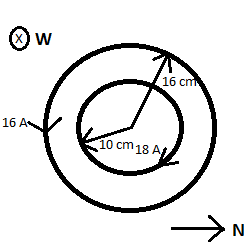
Using the right-hand thumb rule, we can see that the direction of the magnetic field due to coil X will be towards the east direction and that due to coil Y will be in the West direction.
We know the magnetic field at the centre of a circular loop of radius r carrying current I is given by
$B=\frac{\mu _{o}I}{2r}$
$B_{x}=\frac{n_{x}\mu _{o}I_{x}}{2r_{x}}$
$B_{x}=\frac{20\times 4\pi \times 10^{-7}\times 16}{2\times 0.16}$
$B_x=4\pi\times 10^{-4}T$ (towards East)
$B_{y}=\frac{n_{y}\mu _{o}I_{y}}{2r_{y}}$
$B_{y}=\frac{25\times 4\pi \times 10^{-7}\times 18}{2\times 0.1}$
$B_y=9\pi \times10^{-4}T$ (towards west)
The net magnetic field at the centre of the coils,
Bnet =By - Bx =1.57 $\times$ 10-3 T
The direction of the magnetic field at the centre of the coils is towards the west.
Answer:
Strength of the magnetic field required is $100 G ( 1G = 10 ^{-4}) T$
$B=\mu _{o}nI$
$nI=\frac{B}{\mu _{o}}$
$nI \\=\frac{100\times 10^{-4}}{4\pi \times 10^{-7}}\\ \\=7957.74 \approx 8000$
Therefore, keeping the number of turns per unit length and the value of current within the prescribed limits such that their product is approximately 8000, we can produce the required magnetic field.
e.g. n=800 and I=10 A.
$B = \frac{\mu _0 IR^2N}{2 ( x^2 + R^2 )^{3/2}}$
Show that this reduces to the familiar result for the field at the centre of the coil.
Answer:
For a circular coil of radius R and N turns carrying current I, the magnitude of the magnetic field at a point on its axis at a distance x from its centre is given by,
$B = \frac{\mu _0 IR^2N}{2 ( x^2 + R^2 )^{3/2}}$
To find the field at the centre of the coil, we put x=0 and get the familiar result
$B = \frac{\mu _0 IN}{2R}$
$B = \frac{\mu _0 IR^2N}{2 ( x^2 + R^2 )^{3/2}}$
Answer:
Let a point P be at a distance of l from the midpoint of the centres of the coils.
The distance of this point from the centre of one coil would be $R/2+l$, and that from the other would be $R/2-l$.
The magnetic field at P due to one of the coils would be
$B_{1}= \frac{\mu _0 IR^2N}{2 ( (R/2+l)^2 + R^2 )^{3/2}}$
The magnetic field at P due to the other coil would be
$B_{2}= \frac{\mu _0 IR^2N}{2 ( (R/2-l)^2 + R^2 )^{3/2}}$
Since the direction of current in both the coils is the same, the magnetic fields B1 and B2 due to them at point P would be in the same direction
$\begin{aligned} & \mathrm{B}_{\text {net }}=\mathrm{B}_2+\mathrm{B}_1 \\ & B_{n e t}=\frac{\mu_0 I R^2 N}{2\left((R / 2-l)^2+R^2\right)^{3 / 2}}+\frac{\mu_0 I R^2 N}{2\left((R / 2+l)^2+R^2\right)^{3 / 2}} \\ & B_{n e t}=\frac{\mu_0 I R^2 N}{2}\left[\left((R / 2-l)^2+R^2\right)^{-3 / 2}+\left((R / 2+l)^2+R^2\right)^{-3 / 2}\right] \\ & B_{n e t}=\frac{\mu_0 I R^2 N}{2}\left[\left(\frac{R^2}{4}-R l+l^2+R^2\right)^{-3 / 2}+\left(\frac{R^2}{4}+R l+l^2+R^2\right)^{-3 / 2}\right] \\ & B_{n e t}=\frac{\mu_0 I R^2 N}{2}\left[\left(\frac{5 R^2}{4}-R l+l^2\right)^{-3 / 2}+\left(\frac{5 R^2}{4}+R l+l^2\right)^{-3 / 2}\right] \\ & B_{n e t}=\frac{\mu_0 I R^2 N}{2} \times\left(\frac{5 R^2}{4}\right)^{-3 / 2}\left[\left(1-\frac{4 l}{5 R}+\frac{4 l^2}{5 R^2}\right)^{-3 / 2}+\left(1+\frac{4 l}{5 R}+\frac{4 l^2}{5 R^2}\right)^{-3 / 2}\right]\end{aligned}$
Since $l<<R$ we can ignore term $l2 /R2
$\\B_{net}= \frac{\mu _0 IN}{2R}\times (\frac{5}{4})^{-3/2}\left [ ( 1-\frac{4l}{5R} )^{-3/2} + ( 1+\frac{4l}{5R} )^{-3/2}\right ]\\$
$\\B_{net}= \frac{\mu _0 IN}{2R}\times (\frac{4}{5})^{3/2}\left [ 1+\frac{6l}{5R} + 1-\frac{6l}{5R} \right ]\\$
$\\B_{net}= \frac{\mu _0 IN}{2R}\times (\frac{4}{5})^{3/2}\times 2$
$\\B_{net}= 0.715\frac{\mu _0 IN}{R}\approx 0.72\frac{\mu _0 IN}{R}$
Since the above value is independent of $l$ for small values, it is proved that about the midpoint, the Magnetic field is uniform.
Answer:
Outside the toroid, the magnetic field will be zero.
Answer:
The magnetic field inside the core of a toroid is given by
$B=\frac{\mu _{o}NI}{l}$
Total number of turns(N)=3500
Current flowing in toroid =11 A
Length of the toroid,
$\begin{aligned} & l=2 \pi\left(\frac{r_1+r_2}{2}\right) \\ & l=\pi\left(r_1+r_2\right) \quad\left(\mathrm{r}_1=\text { inner radius }=25 \mathrm{~cm}, \mathrm{r}_2=\text { outer radius }=26 \mathrm{~cm}\right) \\ & l=\pi(0.25+0.26) \\ & l=0.51 \pi\end{aligned}$
$B=\frac{4\pi \times 10^{-7}\times 3500\times 11}{0.51\pi }=0.031 T$
Answer:
The magnetic field in the empty space surrounded by the toroid is zero.
Answer:
The charged particle is not deflected by the magnetic field even while having a non-zero velocity; therefore, its initial velocity must be either parallel or anti-parallel to the magnetic field, i.e. its velocity is either towards the east or the west direction.
Answer:
Yes, its final speed will be equal to the initial speed if it has not undergone any collision, as the work done by the magnetic field on a charged particle is always zero because it acts perpendicular to the velocity of the particle.
Answer:
The electron would experience an electrostatic force towards the north direction; therefore, to nullify its force due to the magnetic field must be acting on the electron towards the south direction. By using Fleming's left-hand rule, we can see that the force will be in the north direction if the magnetic field is in the vertically downward direction.
Explanation:
The electron is moving towards the east and has a negative charge; therefore, $\vec{v}$ is towards the west direction. Force will be towards the south direction if the magnetic field is in the vertically downward direction, as $\vec{F}=q\vec{v}\times \vec{B}$
Answer:
The electron has been accelerated through a potential difference of 2.0 kV.
Therefore K.E of electron $=1.6 \times 10^{-19} \times 2000=3.2 \times 10^{-16} \mathrm{~J}$
$\begin{aligned}
& \frac{1}{2} m v^2=3.2 \times 10^{-16} \\
& v=\sqrt{\frac{2 \times 3.2 \times 10^{-16}}{9.1 \times 10^{-31}}} \\
& v=2.67 \times 10^7 \mathrm{~ms}^{-1}
\end{aligned}$
Since the electron initially has velocity perpendicular to the magnetic field, it will move in a circular path.
The magnetic field acts as a centripetal force. Therefore,
$\begin{aligned}
& \frac{m v^2}{r}=e v B \\
& r=\frac{m v}{e B} \\
& r=\frac{9.1 \times 10^{-31} \times 2.67 \times 10^7}{1.6 \times 10^{-19} \times 0.15}=1.01 \mathrm{~mm}
\end{aligned}$
Answer:
The electron has been accelerated through a potential difference of 2.0 kV.
Therefore K.E of electron $=1.6 \times 10^{-19} \times 2000=3.2 \times 10^{-16} \mathrm{~J}$
$\begin{aligned}
& \frac{1}{2} m v^2=3.2 \times 10^{-16} \\
& v=\sqrt{\frac{2 \times 3.2 \times 10^{-16}}{9.1 \times 10^{-31}}} \\
& v=2.67 \times 10^7 \mathrm{~ms}^{-1}
\end{aligned}$
The component of velocity perpendicular to the magnetic field is
$\begin{aligned}
& v_p=v \sin 30^{\circ} \\
& v_p=1.33 \times 10^7 \mathrm{~ms}^{-1}
\end{aligned}$
The electron will move in a helical path of radius r given by the relation,
$\begin{aligned}
& \frac{m v_p^2}{r}=e v_p B \\
& r=\frac{m v_p}{e B} \\
& r=\frac{9.1 \times 10^{-31} \times 1.33 \times 10^7}{1.6 \times 10^{-19} \times 0.15} \\
& \mathrm{r}=5 \mathrm{~m} \\
& \mathrm{r}=5 \times 10^{-4} \mathrm{~m} \\
& \mathrm{r}=0.5 \mathrm{~mm}
\end{aligned}$
The component of velocity along the magnetic field is
$\begin{aligned}
& v_t=v \cos 30^{\circ} \\
& v_t=2.31 \times 10^7 \mathrm{~ms}^{-1}
\end{aligned}$
The electron will move in a helical path of pitch p given by the relation,
$\begin{aligned}
& p=\frac{2 \pi r}{v_p} \times v_t \\
& p=\frac{2 \pi \times 5 \times 10^{-4}}{1.33 \times 10^7} \times 2.31 \times 10^7 \\
& p=5.45 \times 10^{-3} \mathrm{~m} \\
& p=5.45 \mathrm{~mm}
\end{aligned}$
The electron will, therefore, move in a helical path of radius 5 mm and pitch 5.45 mm.
Answer:
$\begin{aligned}
& q E=q v B \\
& E=v B \quad \ldots (i)
\end{aligned}$
Let the beam consist of particles having charge q and mass m.
After being accelerated through a potential difference $V$, its velocity can be found by using the following relation,
$\begin{aligned}
& \frac{1}{2} m v^2=q V \\
& v=\sqrt{\frac{2 q V}{m}} \quad \ldots (ii)
\end{aligned}$
Using the value of $v$ from equation (ii) in (i), we have
$\begin{aligned}
E & =B \sqrt{\frac{2 q V}{m}} \\
\frac{q}{m} & =\frac{E^2}{2 V B^2} \\
\frac{q}{m} & =\frac{\left(9 \times 10^{-5}\right)^2}{2 \times 15 \times 10^3 \times(0.75)^2}=4.8 \times 10^{-13}
\end{aligned}$
Answer:
In order for the tension in the wires to be zero, the force due to the magnetic field must be equal to the gravitational force on the rod.
$mg=BIl$
mass of rod=0.06 g
length of rod=0.45m
The current flowing through the rod=5 A
$B=\frac{mg}{Il}$
$B=\frac{0.06\times 9.8}{5\times 0.45}$
$ B=0.261\ T$
A magnetic field of strength 0.261 T should be set up normal to the conductor in order that the tension in the wires is zero
Answer:
If the direction of the current is reversed, the magnetic force would act in the same direction as that of gravity.
Total tension in wires(T)=Gravitational force on rod + Magnetic force on rod
$\begin{aligned} & T=m g+B I l \\ & T=0.06 \times 9.8+0.261 \times 5 \times 0.45 \\ & T=1.176 \mathrm{~N}\end{aligned}$
The total tension in the wires will be 1.176 N.
Answer:
Since the distance between the wires is much smaller than the length of the wires, we can calculate the Force per unit length on the wires using the following relation.
$F=\frac{\mu _{o}I_{1}I_{2}}{2\pi d}$
Current in both wires=300 A
Distance between the wires=1.5 cm
Permeability of free space=4 $\pi \times$ 10-7 TmA-1
$F=\frac{4\pi \times 10^{-7}\times 300\times 300}{2\pi \times 0.015}$
F=1.2 Nm-1
Answer:
The length of wire inside the magnetic field is equal to the diameter of the cylindrical region = 20.0 cm = 0.2 m.
Magnetic field strenth=1.5 T.
Current flowing through the wire=7.0 A
The angle between the direction of the current and the magnetic field=90o
Force on a wire in a magnetic field is calculated by the relation,
$\\F=BIl\sin\theta \\ $
$F=1.5\times 7\times 0.2$
F=2.1 N
This force, due to the magnetic field inside the cylindrical region, acts on the wire in the vertically downward direction.
Answer:
Magnetic field strenth=1.5 T.
Current flowing through the wire=7.0 A
The angle between the direction of the current and the magnetic field = 45o
The radius of the cylindrical region=10.0 cm
The length of wire inside the magnetic field, $\\l=\frac{2r}{sin\theta }\\$
Force on a wire in a magnetic field is calculated by the relation,
$\\F=BIl\sin\theta \\ $
$\\F=1.5\times 7\times \frac{2\times 0.1}{sin45^{o}}\times sin45^{o}$
F=2.1 N
This force, due to the magnetic field inside the cylindrical region, acts on the wire in the vertically downward direction.
This force will be independent of the angle between the wire and the magnetic field, as we can see in the above case.
Note: There is one case in which the force will be zero, and that will happen when the wire is kept along the axis of the cylindrical region.
Answer:
The wire is lowered by a distance d=6cm.
In this case, the length of the wire inside the cylindrical region decreases.
Let this length be $l$.
$\begin{aligned} & \left(\frac{l}{2}\right)^2+d^2=r^2 \\ & \left(\frac{l}{2}\right)^2=0.1^2-0.06^2 \\ & \left(\frac{l}{2}\right)^2=0.01-0.0036 \\ & \left(\frac{l}{2}\right)^2=0.0064 \\ & \frac{l}{2}=0.08 \\ & l=0.16 \mathrm{~m} \\ & F=B I l \sin \theta \\ & F=1.5 \times 7 \times 0.16 \\ & \mathrm{~F}=1.68 \mathrm{~N}\end{aligned}$
This force acts in the vertically downward direction.
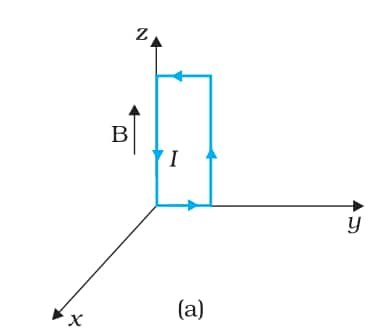
Answer:
The magnetic field is
$\vec{B}=3000\ G \hat{k}=0.3\ T\hat{k}$
Current in the loop=12 A
Area of the loop = length $\times$ breadth
A=0.1 $\times$ 0.05
A=0.005 m2
$\vec{A}=0.005\ m^{2}\hat{i}$
Torque is given by,
$\begin{aligned} & \vec{\tau}=I \vec{A} \times \vec{B} \\ & \vec{\tau}=12 \times 0.005 \hat{i} \times 0.3 \hat{k} \\ & \vec{\tau}=-0.018 \hat{j}\end{aligned}$
The torque on the loop has a magnitude of 0.018 Nm and acts along the negative-y direction. The force on the loop is zero.
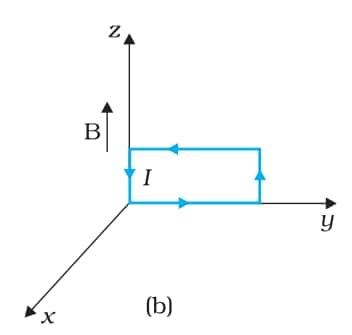
Answer:
The magnetic field is
$\vec{B}=3000\ G \hat{k}=0.3\ T\hat{k}$
Current in the loop=12 A
Area of the loop = length $\times$ breadth
A=0.1 $\times$ 0.05
A=0.005 m2
$\vec{A}=0.005\ m^{2}\hat{i}$ (same as that in the last case)
$\begin{aligned} & \vec{\tau}=I \vec{A} \times \vec{B} \\ & \vec{\tau}=12 \times 0.005 \hat{i} \times 0.3 \hat{k} \\ & \vec{\tau}=-0.018 \hat{j}\end{aligned}$
The torque on the loop has a magnitude of 0.018 Nm and acts along the negative-y direction. The force on the loop is zero.
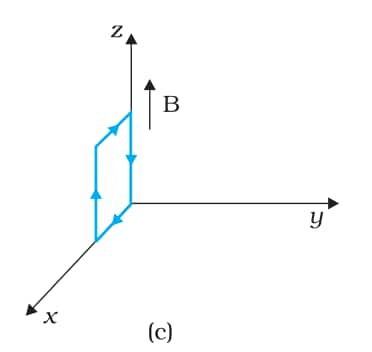
Answer:
The magnetic field is
$\vec{B}=3000\ G \hat{k}=0.3\ T\hat{k}$
Current in the loop=12 A
Area of the loop = length $\times$ breadth
A=0.1 $\times$ 0.05
A=0.005 m2
$\vec{A}=-0.005\ m^{2}\hat{j}$
Torque is given by,
$\begin{aligned}
& \vec{\tau}=I \vec{A} \times \vec{B} \\
& \vec{\tau}=12 \times-0.005 \hat{j} \times 0.3 \hat{k} \\
& \vec{\tau}=-0.018 \hat{i}
\end{aligned}$
The torque on the loop has a magnitude of 0.018 Nm and acts along the negative-x-direction. The force on the loop is zero.
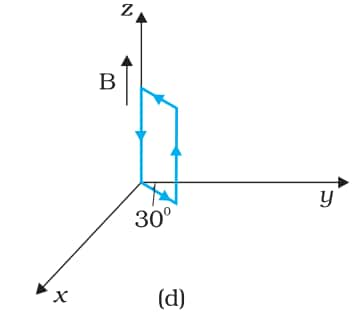
Answer:
The magnetic field is
$\vec{B}=3000\ G \hat{k}=0.3\ T\hat{k}$
Current in the loop=12 A
Area of the loop = length $\times$ breadth
A=0.1 $\times$ 0.05
A=0.005 m2
$\vec{A}=0.005\ m^{2}(-\frac{\hat{i}}{2}+\frac{\sqrt{3}}{2}\hat{j})$
Torque is given by,
$\begin{aligned}
& \vec{\tau}=I \vec{A} \times \vec{B} \\
& \vec{\tau}=12 \times 0.005\left(-\frac{\hat{i}}{2}+\frac{\sqrt{3}}{2} \hat{j}\right) \times 0.3 \hat{k} \\
& \vec{\tau}=-0.018\left(\frac{\hat{i}}{2}+\frac{\sqrt{3}}{2} \hat{j}\right)
\end{aligned}$
The torque on the loop has a magnitude of 0.018 Nm and is at an angle of 240° from the positive x-direction. The force on the loop is zero.
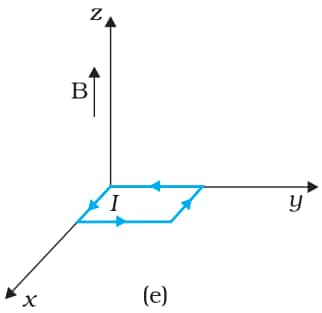
Answer:
The magnetic field is
$\vec{B}=3000\ G \hat{k}=0.3\ T\hat{k}$
Current in the loop=12 A
Area of the loop = length $\times$ breadth
A=0.1 $\times$ 0.05
A=0.005 m2
$\vec{A}=0.005\ m^{2}\hat{k}$
Since the area vector is along the direction of the magnetic field, the torque on the loop is zero. The force on the loop is zero.

Answer:
The magnetic field is
$\vec{B}=3000\ G \hat{k}=0.3\ T\hat{k}$
Current in the loop=12 A
Area of the loop = length $\times$ breadth
A=0.1 $\times$ 0.05
A=0.005 m2
$\vec{A}=-0.005\ m^{2}\hat{k}$
Since the area vector is in the opposite direction of the magnetic field, the torque on the loop is zero. The force on the loop is zero.
The force on the loop in all the above cases is zero, as the magnetic field is uniform
Answer:
As we know, the torque on a current-carrying loop in a magnetic field is given by the following relation
$\\\vec{\tau }=I\vec{A}\times \vec{B}\\$
It is clear that the torque, in this case, will be 0 as the area vector is along the magnetic field only.
Answer:
The total force on the coil will be zero as the magnetic field is uniform.
Answer:
The average force on each electron in the coil due to the magnetic field will be eVdB, where Vd is the drift velocity of the electrons.
The current is given by
$I=neAv_{d}$
where n is the free electron density and A is the cross-sectional area.
$v_{d}=\frac{I}{neA}$
$v_{d}=\frac{5}{10^{29}\times 1.6\times 10^{-19}\times 10^{-5}}$
$v_d=3.125\times10^{-5} ms^{-1}$
The average force on each electron is
$F=ev_dB$
$F=1.6\times10^{-19}\times3.125\times10^{-5}\times00.1$
$F=5\times10^{-25} N$
Answer:
The magnetic field inside the solenoid is given by
$B=\mu _{0}nI$
n is the number of turns per unit length
$n=\frac{3\times 300}{0.6}$
n=1500 m-1
Current in the wire Iw = 6 A
Mass of the wire m = 2.5 g
Length of the wire l = 2 cm
The windings of the solenoid would support the weight of the wire when the force due to the magnetic field inside the solenoid balances the weight of the wire
$\begin{aligned} & B I_w l=m g \\ & B=\frac{m g}{I_w l} \\ & \mu_0 n I=\frac{m g}{I_w l} \\ & I=\frac{m g}{I_w l \mu_0 n} \\ & I=\frac{2.5 \times 10^{-3} \times 9.8}{6 \times 0.02 \times 4 \pi \times 10^{-7} \times 1500} \\ & I=108.37 \mathrm{~A}\end{aligned}$
Therefore, a current of 108.37 A in the solenoid would support the wire.
Answer:
The galvanometer can be converted into a voltmeter by connecting an appropriate resistor of resistance R in series with it.
At the full-scale deflection current(I) of 3 mA, the voltmeter must measure a Voltage of 18 V.
The resistance of the galvanometer coil G = $12 \Omega$
$I$ $\times$ $(R+G)=18 V$
$R=\frac{18}{3\times 10^{-3}}-12$
$R=6000-12=5988\Omega$
The galvanometer can be converted into a voltmeter by connecting a resistor of resistance $5988\Omega$ in series with it.
Answer:
The galvanometer can be converted into an ammeter by connecting an appropriate resistor of resistance R in series with it.
At the full-scale deflection current(I) of 4 mA, the ammeter must measure a current of 6 A.
The resistance of the galvanometer coil is G = $15 \Omega$
Since the resistor and galvanometer coil are connected in parallel, the potential difference is the same across them.
$\begin{aligned} & I G=(6-I) R \\ & R=\frac{I G}{6-I} \\ & R=\frac{4 \times 10^{-3} \times 15}{6-4 \times 10^{-3}} \\ & R \approx 0.01 \Omega\end{aligned}$
The galvanometer can be converted into an ammeter by connecting a resistor of resistance $0.01\Omega$ in parallel with it.
Understanding class 12 NCERT solutions on moving charges and magnetism is similar to constructing a tall building's base. It is essential for passing difficult entrance examinations like JEE and NEET (like the support system that holds up the building) and for performing well on your regular school exams (like the bricks at the bottom).
Class 12 Physics Chapter 4 - Moving charges and magnetism: Higher Order Thinking Skills (HOTS) Questions
Class 12 Physics Chapter 4 Moving Charges and Magnetism includes HOTS questions that test a student’s deep understanding of the magnetic effects of current. These questions encourage logical thinking and application of concepts like the Biot–Savart law, Ampere’s law, and the motion of charged particles in magnetic fields. Solving these helps students strengthen their problem-solving skills and prepare effectively for board and competitive exams.
Question 1: A charged particle is thrown into space with a uniform magnetic field and a uniform electric field.
Choose the correct possibility of the path of the charged particle.
1) The path of a charged particle may be a straight line, cycloidal or helical.
2) The path of the charged particle may be elliptical.
3) If the electric field is removed path of the charge particle must be circular
4) None of the above
Answer:
In a pure uniform electric field, any charged particle will either move in a straight line or a parabolic path.
In a pure uniform magnetic field, any charged particle will either move on a circular path or a helical path.
In the presence of an electric field and a magnetic field, the charged particle may move on a straight line if the magnetic force balances the electric force
This situation comes in the case of a velocity selector.
If the electric field and magnetic field are parallel, then the charge particle will follow a helical path.
If the electric field and magnetic field are perpendicular to each other, then the charged particle may follow the cycloidal path.
Hence, the answer is option (1).
Question 2: A particle of charge ' $q$ ' and mass ' $m$ ' is thrown from origin with velocity $\vec{v}=v \hat{i}+v \hat{j}$ in the magnetic field $\vec{B}=B \hat{i}$. Find out the correct statement
1) The coordinates of the charge particle at $t=\frac{2 \pi m}{q B}$ are $x=\frac{2 \pi m}{q B} ; y=0 ; z=0$
2) The coordinates of the charge particle at $t=\frac{\pi m}{q B}$ are $x=\frac{\pi m v}{q B} ; y=0 ; z=\frac{-2 m v}{q B}$
3) The coordinates of the charge particle at $t=\frac{\pi m}{6 q B}$ are $\quad x=\frac{\pi m v}{6 q B} ; y=\frac{m v}{2 q B} ; z=-\frac{\sqrt{3}}{2} \frac{m v}{q B}$
4) All are incorrect
Answer:
The particle will follow the helical path, which has a circular projection in the Y–Z plane and a straight-line motion along the x-axis.
In the Y-Z plane, it will perform circular motion with
$R=\frac{m v}{q B}$ and $T=\frac{2 \pi m}{q B}$

and centre of circle is at $(Z=-R, Y=0)$
At general time its $Y$ and $Z$ coordinate will be
$
Y=R \sin \theta, Z=-R(1-\cos \theta) \text { and }
$
Its X coordinate increases linearly with speed v.
(a) at $\mathrm{t}=\frac{2 \pi \mathrm{~m}}{\mathrm{qB}} \Rightarrow \quad \theta=2 \pi \Rightarrow x=\frac{2 \pi \mathrm{mv}}{\mathrm{qB}} ; \mathrm{y}=0 ; \mathrm{z}=0$
(b) at $\mathrm{t}=\frac{\pi \mathrm{m}}{\mathrm{qB}} \Rightarrow \theta=\pi \Rightarrow x=\frac{\pi \mathrm{mv}}{\mathrm{qB}} ; \mathrm{y}=0 ; \mathrm{z}=\left(\frac{-2 m v}{q B}\right)$
(c) at $\mathrm{t}=\frac{\pi \mathrm{m}}{6 \mathrm{qB}} \Rightarrow \theta=\pi / 6 \Rightarrow \quad \mathrm{x}=\frac{\pi \mathrm{mv}}{6 \mathrm{qB}} ; \mathrm{y}=\frac{\mathrm{mv}}{2 \mathrm{qB}} ; \mathrm{z}=\frac{-\mathrm{mv}}{\mathrm{qB}}\left(1-\frac{\sqrt{3}}{2}\right)$
Hence, the answers are option(1) and option(2).
Question 3: Choose the correct statement about the magnetic field.
1) Any charged particle in the magnetic field must experience a force due to it.
2) Any moving charged particle in the magnetic field must experience a force due to it.
3) The work done by the magnetic force on a moving charge particle is always zero.
4) The work done by the magnetic force on a current-carrying wire may be non-zero.
Answer:
The magnetic field can apply a force on a moving charge particle if its velocity is not parallel to the magnetic field.
The result can be easily viewed on the basis of the Lorentz force.
It says the force is obtained by the cross product of the velocity of the charge particle and the magnetic field.
Magnetic force never does any work, neither on a charge nor on a current-carrying wire.
Hence, the answer is option (3).
Question 4: Two proton beams are moving parallel to each other with the same velocity v along their beam direction at some separation. Find out the correct option(s):
1) Ratio of electrostatic repulsive and magnetic attraction force is $\frac{c^2}{v^2}$
2) Ratio of electrostatic repulsive and magnetic attraction force is $\frac{v^2}{c^2}$
3) Electrostatic force per unit length of any beam is $\frac{2 \mathrm{Kn}^2 e^2}{\mathrm{r}}$
Magnetic force per unit length of any beam is $\frac{\mu_0 n^2 e^2 v^2}{2 \pi r}$
4) Electrostatic force per unit length of any beam is $\frac{\mu_0 n^2 e^2 v^2}{2 \pi r}$
Magnetic force per unit length of any beam is $\frac{2 \mathrm{Kn}^2 \mathrm{e}^2}{r}$
Answer:
Let there be n protons in a unit length
So charge / length, $\lambda=$ ne
Effective current in proton beam $=$ nev
Now electrostatic force per unit length of any beam
$
\mathrm{F}_e=\frac{2 \mathrm{~K} \lambda_1 \lambda_2}{\mathrm{r}}=\frac{2 \mathrm{~K}(\mathrm{ne})(\mathrm{ne})}{\mathrm{r}}
$
Magnetic force per unit length of any beam
$
\begin{aligned}
& \mathrm{F}_{\mathrm{m}}=\frac{\mu_0 \mathrm{i}_1 \mathrm{i}_2}{2 \pi \mathrm{r}}=\frac{\mu_0(\mathrm{nev})(\mathrm{nev})}{2 \pi \mathrm{r}} \\
& \text { So, } \frac{\mathrm{F}_{\mathrm{e}}}{\mathrm{~F}_{\mathrm{m}}}=\frac{1}{\mu_0 \in_0 \mathrm{v}^2}=\frac{\mathrm{c}^2}{\mathrm{v}^2}
\end{aligned}
$
Hence, the correct answers are options (1) and (3).
Question 5: A proton, a deuterium nucleus, and an alpha particle are accelerated through the same potential difference. Now, these particles are sent in a uniform magnetic field perpendicular. Choose the correct ratio(s):
1) Their radii of circles $=1: \sqrt{2}: \sqrt{2}$
2) Their angular momentum $=1: 2: 4$
3) Their frequencies of periodic motion $=2: 1: 1$
4) All the above are correct
Answer:
If charge ' $q$ ' is accelerated through potential difference $\Delta V$, its kinetic energy will be :
$
\text { K.E. }=\mathrm{q} \Delta \mathrm{~V} \quad \Rightarrow \quad \frac{1}{2} \mathrm{mv}^2=\mathrm{q} \Delta \mathrm{~V}
$
In a magnetic field,
$
r=\frac{m v}{q B} ; L=\frac{m^2 v^2}{q B} ; f=\frac{q B}{2 \pi m}
$
Proton, deuterium, and a particle have charge and mass as $(e, m)(e, 2 m) \&(2 e, 4 m)$ respectively.
(a) So, their ratio of radii :
$
r_p: r_d: r_\alpha=\frac{\sqrt{2 m e \Delta V}}{e B}: \frac{\sqrt{4 m e \Delta V}}{e B}: \frac{\sqrt{16 m e \Delta V}}{2 e B} \Rightarrow r_p: r_d: r_\alpha=1:
$
$
\sqrt{2}: \sqrt{2}
$
(b) Their ratio of angular momentum :
$
L_p: L_d: L_\alpha=\frac{2 m e \Delta V}{e B}: \frac{4 m e \Delta V}{e B}: \frac{16 m e \Delta V}{2 e B} \Rightarrow L_p: L_d: L_\alpha=1:
$
(c) Their ratio of frequencies:
$
f_p: f_d: f_\alpha=\frac{e B}{2 \pi m}: \frac{e B}{4 \pi m}: \frac{2 e B}{8 \pi m} \Rightarrow f_p: f_d: f_\alpha=2: 1: 1
$
Hence, the answer is option (4).
Moving Charges and Magnetism Class 12 Question Answers: Topics
Class 12 Physics Chapter 4 - Moving charges and magnetism addresses the nature of magnetic fields generated by moving electric charges, the properties of such fields, how they interact with other moving charges, and with currents. It prepares the ground to study the magnetic effects of current, which play an essential role both in electromagnetism and in modern technology.
4.1 Introduction
4.2 Magnetic Force
4.2.1 Sources And Fields
4.2.2 Magnetic Field, Lorentz Force
4.2.3 Magnetic Force On A Current-Carrying Conductor
4.3 Motion In A Magnetic Field
4.4 Magnetic Field Due To A Current Element, Biot-Savart Law
4.5 Magnetic Field On The Axis Of A Circular Current Loop
4.6 Ampere’s Circuital Law
4.7 The Solenoid
4.8 Force Between Two Parallel Currents, The Ampere
4.9 Torque On Current Loop, Magnetic Dipole
4.9.1 Torque On A Rectangular Current Loop In A Uniform Magnetic Field
4.9.2 Circular Current Loop As A Magnetic Dipole
4.10 The Moving Coil Galvanometer
Class 12 Physics Chapter 4 - Moving charges and magnetism: Important Formulas
The Important Formulas section of Class 12 Physics Chapter 4 - Moving charges and magnetism has all the important equations in a single section, and therefore, the student can easily revise and solve numerical problems like a machine. Such equations deal with concepts such as magnetic force on a moving charge, Biot-Savart Law, Ampere Circuital Law, force between current-carrying wires, and acceleration of charged particles in magnetic fields.
1. Magnetic Force on a Moving Charge (Lorentz Force):
$F=q(\vec{v} \times \vec{B})$
Where:
$F=$ Force on the charge
$q=$ Charge of the particle
$\vec{v}=$ Velocity of the particle
$\vec{B}=$ Magnetic field
The force is perpendicular to both the velocity and the magnetic field.
2. Magnetic Force on a Current-Carrying Conductor:
$F=I L B \sin \theta$
Where:
$I=$ Current
$L=$ Length of the conductor
$B=$ Magnetic field
$\theta=$ Angle between the magnetic field and the conductor
3. Magnetic Field due to a Current-Carrying Conductor (Biot-Savart Law):
$d B=\frac{\mu_0}{4 \pi} \frac{I d l \sin \theta}{r^2}$
Where:
$dB=$ Small magnetic field element
$I=$ Current
$d l=$ Small length of the conductor
$r=$ Distance from the point to the wire
$\theta=$ Angle between $dl$ and the line joining the point and element
4. Magnetic Field due to a Long Straight Current-Carrying Wire:
$B=\frac{\mu_0 I}{2 \pi r}$
Where:
$I=$ Current
$r=$ Distance from the wire
$B=$ Magnetic field at a distance $r$ from the wire
5. Ampere's Law:
$\oint \vec{B} \cdot d \vec{l}=\mu_0 I_{\mathrm{enc}}$
Where:
$\oint \vec{B} \cdot d \vec{l}=$ Line integral of the magnetic field
$\mu_0=$ Permeability of free space
$I_{\mathrm{enc}}=$ Total enclosed current
6. Magnetic Field due to a Circular Loop:
$B=\frac{\mu_0 I}{2 R}$ at the center of the loop
Where:
$I=$ Current in the loop
$R=$ Radius of the loop
7. Force between Two Parallel Current-Carrying Conductors:
$F=\frac{\mu_0 I_1 I_2 L}{2 \pi r}$
Where:
$I_1, I_2=$ Currents in the two wires
$L=$ Length of the wire
$r=$ Distance between the wires
Approach to Solve Questions of Class 12 Physics Chapter 4 - Moving charges and magnetism
The Moving charges and magnetism class 12 question answers need to be approached in a systematic manner. By concentrating on relevant physical quantities, an appropriate choice of laws, and visualisation of directions of forces and fields, one can effectively address numerical and conceptual problems with a high degree of accuracy and excellent understanding of underlying concepts.
Learn about the Concept First
- Revise simple concepts such as magnetic force on a moving charge, magnetic field resulting from a current element (Biot-Savart Law), and Ampere Circuital Law.
- Obtain the directions of the vectors through the use of the right-hand rule.
Make a Neat Diagram
- When loops or wires are carrying current, draw the correct diagrams indicating the current flow and magnetic field lines.
Apply Right-Hand Rules
- The direction of the magnetic field caused by the current may be found by the right-hand thumb rule.
- Use the rule of Lorentz force (F = q(v x B)) on a moving charge.
Determine the required Formula
- Identify the concept underlying the question:
- Moving charge and magnetic force
- Biot-Savart Law
- The forces acting on a current-carrying wire
- Movement of charged particles in magnetic fields
- Applications of Ampere's law
What Extra Should Students Study Beyond the NCERT for JEE/NEET?
In order to succeed in competitive exams such as JEE and NEET, students must look beyond NCERT and learn more about the practice of concepts in Class 12 Physics Chapter 4 - Moving charges and magnetism. These involve solving complicated numerical problems, learning relations in the magnetic fields and practising derivations and real-world applications to reinforce problem-solving capabilities and conceptual clarity.
Importance in Exams
As the CBSE board exam is concerned, the solutions of NCERT Class 12 Physics chapter 4 Moving Charges and Magnetism are important. In CBSE board exams, 12 % of questions are asked from chapters 4 and 5. Same questions discussed in Chapter 4, Physics Class 12 NCERT solutions can be expected in the board exams.
NCERT Solutions for Class 12 Physics: Chapter-Wise
The NCERT Solutions for Class 12 Physics are compiled in a chapter-wise format to make learning and revision simple. Each chapter link provides step-by-step solutions to textbook exercises, additional questions, HOTS, and key formulas. With these well-structured resources, students can prepare effectively for CBSE board exams as well as competitive exams like JEE and NEET.
Also, check NCERT Books and NCERT Syllabus here:
- NCERT Books Class 12 Physics
- NCERT Syllabus Class 12 Physics
- NCERT Books Class 12
- NCERT Syllabus Class 12
NCERT solutions subject-wise
- NCERT solutions for class 12 mathematics
- NCERT solutions for class 12 chemistry
- NCERT solutions for class 12 physics
- NCERT solutions for class 12 biology
Also, check NCERT Exemplar Class 12 Solutions
Frequently Asked Questions (FAQs)
By connecting concepts (such as the motion of charges in magnetism and right-hand/left-hand rules), creating supporting diagrams, applying physical laws methodically, and comparing solutions to common CBSE patterns as shown in the NCERT Solutions, students learn to construct clear conceptual frameworks.
The BiotSavart Law is useful to determine the magnetic field of a small element of current at a point in space. It is critical to the study of magnetic action of currents in wires and loops.
The Ampere's Circuital Law is used to calculate the magnetic field in the field around a closed loop in relation to the total current flowing through the loop simplifying the computations of symmetrical distributions of current such as solenoids and toroids.
Indeed, this chapter has concepts that are used in electric motors, solenoids, generators, loudspeakers, and MRI machines.
Apply a mix of magnetic field, magnetic force formulae, Ampere law and right hand/left hand rule. Demonstrate through draw diagrams to get a clear picture of the directions of fields and forces.
Yes, the NCERT solutions cover all textbook questions with step-by-step explanations, making them sufficient for CBSE exams.
Many students may find it puzzling; however, NCERT Solutions explains that parallel currents attract and anti-parallel currents repel. There are step-by-step explanations with pictures of the right-hand rule, and common mistakes, such as misjudging the direction of the magnetic field surrounding wires, are immediately addressed with examples and logic.
By connecting concepts (such as the motion of charges in magnetism and right-hand/left-hand rules), creating supporting diagrams, applying physical laws methodically, and comparing solutions to common CBSE patterns as shown in the NCERT Solutions, students learn to construct clear conceptual frameworks.
Many students may find it puzzling; however, NCERT Solutions explains that parallel currents attract and anti-parallel currents repel. There are step-by-step explanations with pictures of the right-hand rule, and common mistakes, such as misjudging the direction of the magnetic field surrounding wires, are immediately addressed with examples and logic.
Questions related to CBSE Class 12th
On Question asked by student community
Hello,
You can get the Class 11 English Syllabus 2025-26 from the Careers360 website. This resource also provides details about exam dates, previous year papers, exam paper analysis, exam patterns, preparation tips and many more. you search in this site or you can ask question we will provide you the direct link to your query.
LINK: https://school.careers360.com/boards/cbse/cbse-class-11-english-syllabus
Hello,
No, it’s not true that GSEB (Gujarat Board) students get first preference in college admissions.
Your daughter can continue with CBSE, as all recognized boards CBSE, ICSE, and State Boards (like GSEB) which are equally accepted for college admissions across India.
However, state quota seats in Gujarat colleges (like medical or engineering) may give slight preference to GSEB students for state-level counselling, not for all courses.
So, keep her in CBSE unless she plans to apply only under Gujarat state quota. For national-level exams like JEE or NEET, CBSE is equally valid and widely preferred.
Hope it helps.
Hello,
The Central Board of Secondary Education (CBSE) releases the previous year's question papers for Class 12.
You can download these CBSE Class 12 previous year question papers from this link : CBSE Class 12 previous year question papers (http://CBSE%20Class%2012%20previous%20year%20question%20papers)
Hope it helps !
Hi dear candidate,
On our official website, you can download the class 12th practice question paper for all the commerce subjects (accountancy, economics, business studies and English) in PDF format with solutions as well.
Kindly refer to the link attached below to download:
CBSE Class 12 Accountancy Question Paper 2025
CBSE Class 12 Economics Sample Paper 2025-26 Out! Download 12th Economics SQP and MS PDF
CBSE Class 12 Business Studies Question Paper 2025
CBSE Class 12 English Sample Papers 2025-26 Out – Download PDF, Marking Scheme
BEST REGARDS
Hello,
Since you have passed 10th and 12th from Delhi and your residency is Delhi, but your domicile is UP, here’s how NEET counselling works:
1. Counselling Eligibility: For UP NEET counselling, your UP domicile makes you eligible, regardless of where your schooling was. You can participate in UP state counselling according to your NEET rank.
2. Delhi Counselling: For Delhi state quota, usually 10th/12th + residency matters. Since your school and residency are in Delhi, you might also be eligible for Delhi state quota, but it depends on specific state rules.
So, having a Delhi Aadhaar will not automatically reject you in UP counselling as long as you have a UP domicile certificate.
Hope you understand.
Applications for Admissions are open.
As per latest syllabus. Physics formulas, equations, & laws of class 11 & 12th chapters
JEE Main Important Chemistry formulas
Get nowAs per latest syllabus. Chemistry formulas, equations, & laws of class 11 & 12th chapters
JEE Main high scoring chapters and topics
Get nowAs per latest 2024 syllabus. Study 40% syllabus and score upto 100% marks in JEE
JEE Main Important Mathematics Formulas
Get nowAs per latest syllabus. Maths formulas, equations, & theorems of class 11 & 12th chapters

